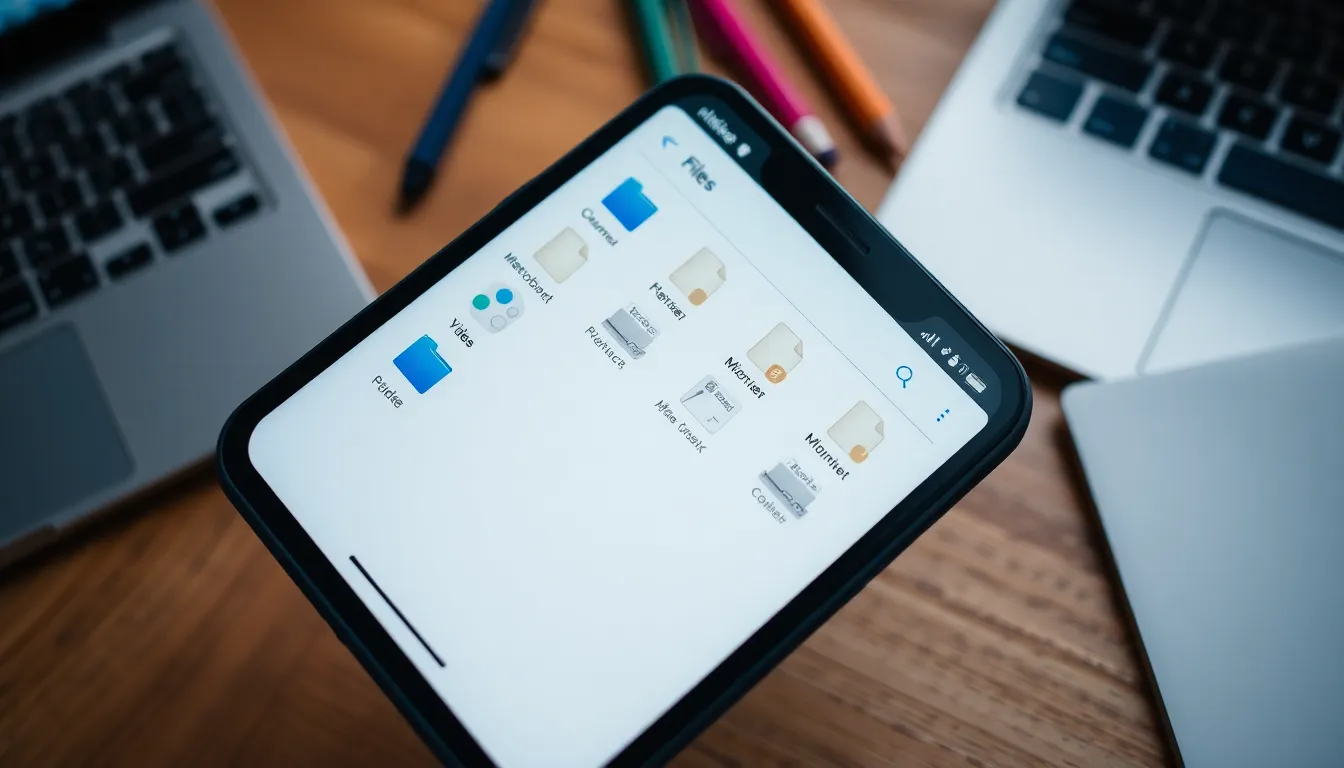Navigating through an iPhone can sometimes feel like searching for a needle in a haystack—if that needle were a vital document and the haystack was a sleek, minimalist interface. But don’t fret! Unlocking the secrets of your iPhone’s file system is easier than finding that elusive pair of socks you swear you just bought.
Table of Contents
ToggleUnderstanding iPhone File Management
Navigating the iPhone’s file system becomes easier with a grasp of its features and functionalities. File management involves knowing where to locate and organize files effectively.
Files App Overview
The Files app serves as the central hub for file access on an iPhone. Users can browse, search, and manage documents, images, and other files effortlessly. The app includes sections for different storage locations like iCloud Drive and third-party cloud services. A unified view allows users to quickly identify and retrieve their files. By using tags, individuals can sort and categorize their documents for streamlined access. Additionally, sharing options enable collaboration or sending files through email and messaging apps.
Other File Management Options
Beyond the Files app, several additional tools enhance file management on the iPhone. Native apps like Photos grant access to images and videos stored in the device. Users can also access music, podcasts, and videos through dedicated apps. On top of that, cloud storage solutions such as Google Drive, Dropbox, or OneDrive provide alternative ways to manage files outside the iPhone. Each app comes with unique features for organizing and sharing content. Utilizing these options expands file management capabilities, catering to diverse user needs.
Ways To See Files On iPhone

Navigating the iPhone for file access can be straightforward with the right knowledge. Several methods allow users to view their files efficiently.
Using The Files App
The Files app acts as the central access point for managing documents and images. Users can browse files stored on iCloud Drive and other cloud services directly from this app. To open the Files app, tap its icon on the home screen. A range of folders and locations appears, making navigation simple. Users can also use the search bar at the top to locate specific files rapidly. Tags can enhance organization within the app, enabling easier sorting through categories like work or personal. Sharing files with others becomes a breeze, promoting seamless collaboration.
Accessing Files Through Third-Party Apps
Many third-party apps also offer file management capabilities. Apps such as Google Drive and Dropbox allow users to store and access files without using the Files app. To start, users must download the desired app from the App Store. After logging into their accounts, they can instantly view and manage files synced to these platforms. Each app presents its own interface, often featuring folders and search options for convenience. Users can share files directly from these apps, improving efficiency for collaborative projects. In addition, linking these apps to the Files app enhances overall accessibility for files across various platforms.
Tips For File Organization On iPhone
Organizing files on an iPhone enhances efficiency and makes retrieval straightforward. Using features such as folders, tags, and search options simplifies file management.
Creating Folders
Folders help users categorize files based on projects, topics, or personal preferences. To create a folder in the Files app, tap the “Folder” icon located in the upper right corner. Naming folders intuitively increases the chances of locating them quickly. Moving files into designated folders can declutter the main view, making navigation smoother. Users can also create nested folders for even more granular organization. This method proves beneficial when managing numerous documents or images.
Using Tags and Search Features
Tags offer a flexible way to organize and classify files. Users can assign colors to tags for visual recognition. Making use of these tags helps locate files quickly across various folders. The search feature also enhances file management; typing keywords in the search bar can display relevant results instantly. Filtering by tags further refines searches, allowing for faster access to needed documents. By combining tags and search functions, users streamline their file retrieval process, significantly reducing time spent searching.
Troubleshooting File Visibility Issues
File visibility issues on an iPhone can hinder access to important documents. Recognizing common problems can aid in resolving them effectively.
Common Problems and Solutions
One common issue involves files not appearing in the Files app. This often occurs when files aren’t saved correctly or the app requires a refresh. Checking iCloud Drive settings can help; ensure the option is enabled for the app to display files. Files may also be located in third-party apps, like Dropbox or Google Drive. Users should verify the integration of these apps within the Files app. In cases where a file doesn’t appear after a recent upload, refreshing the app or restarting the device can solve the problem. Lastly, verifying network connectivity can clarify if files stored online are accessible.
When To Seek Professional Help
Sometimes issues may not resolve with DIY methods. If files remain inaccessible after following standard troubleshooting steps, seeking professional help may be wise. Unresponsive apps or persistent crashing can indicate deeper software malfunctions. Users experiencing these symptoms can benefit from contacting Apple Support directly. Data loss concerns also merit expert assistance; professionals have resources to recover lost files safely. Users should consider taking their iPhone to an authorized service provider when hardware issues are suspected. Prompt action can prevent further complications with file visibility and overall device performance.
Navigating the iPhone’s file system doesn’t have to be daunting. With the right tools and strategies users can easily access and manage their files. The Files app stands out as a powerful resource for organizing documents and images while third-party apps like Google Drive and Dropbox offer additional flexibility.
By utilizing folders and tags users can streamline their file retrieval process making it efficient and hassle-free. Troubleshooting tips ensure that any visibility issues are quickly resolved allowing for smooth file management. Embracing these techniques can transform the way users interact with their iPhone’s files enhancing productivity and collaboration.






